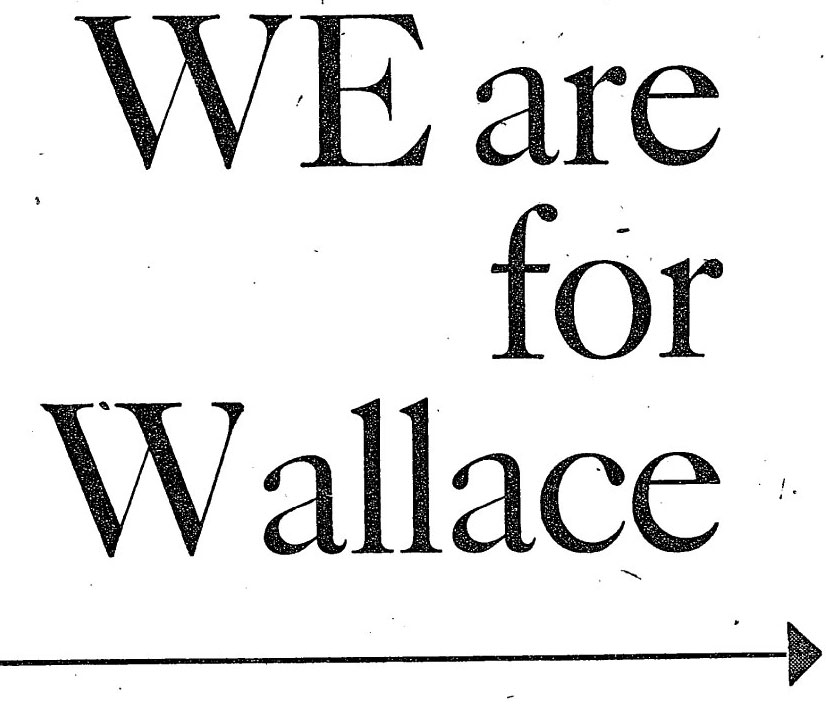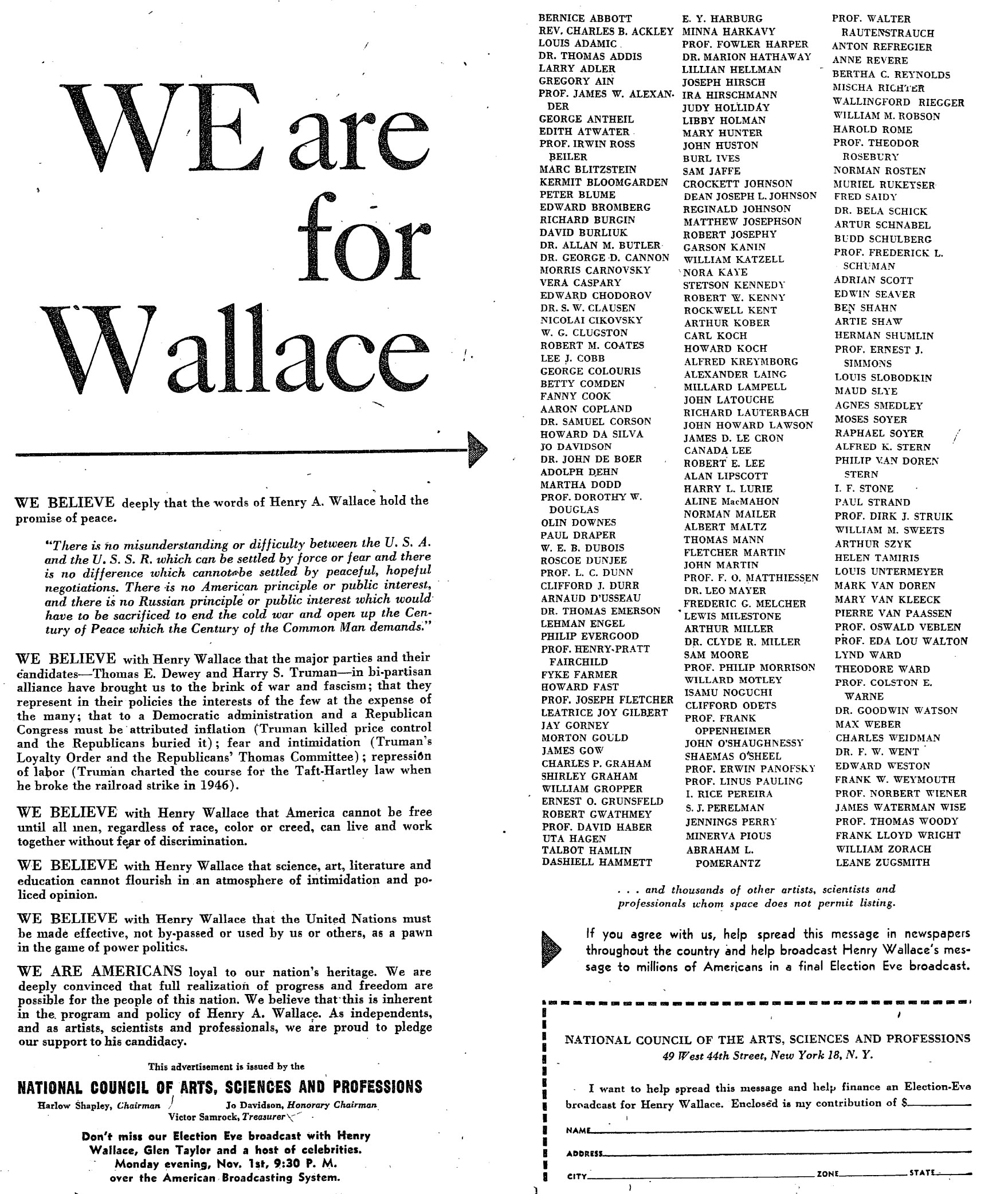 At the risk of further alienating this blog’s modest readership, here is the second of four appendices cut from The Purple Crayon and a Hole to Dig: The Lives of Crockett Johnson and Ruth Krauss (forthcoming from University Press of Mississippi, 2012). Â As is true of Appendix A, this one also registers Johnson’s alliance with the Popular Front, an anti-Fascist coalition of leftists, liberals, and even some moderates. Â (For more on the subject, please see Michael Denning’s The Cultural Front [Verso, 1998]; for more on children’s literature and the Popular Front, check out Julia Mickenberg’s Learning from the Left: Children’s Literature, the Cold War, and Radical Politics in the United States [Oxford UP, 2006].) Â At this point (1948), however, the onset of the Cold War had begun to unravel the Popular Front – Wallace, FDR’s former Vice President, now garnered the support primarily of those on the left. Â Liberals and some moderates went for Truman.
At the risk of further alienating this blog’s modest readership, here is the second of four appendices cut from The Purple Crayon and a Hole to Dig: The Lives of Crockett Johnson and Ruth Krauss (forthcoming from University Press of Mississippi, 2012). Â As is true of Appendix A, this one also registers Johnson’s alliance with the Popular Front, an anti-Fascist coalition of leftists, liberals, and even some moderates. Â (For more on the subject, please see Michael Denning’s The Cultural Front [Verso, 1998]; for more on children’s literature and the Popular Front, check out Julia Mickenberg’s Learning from the Left: Children’s Literature, the Cold War, and Radical Politics in the United States [Oxford UP, 2006].) Â At this point (1948), however, the onset of the Cold War had begun to unravel the Popular Front – Wallace, FDR’s former Vice President, now garnered the support primarily of those on the left. Â Liberals and some moderates went for Truman.
The results of this presidential election (1948) confirm the Popular Front’s demise: Progressive Party candidate Wallace came in fourth, just behind Dixiecrat Strom Thurmond. Â Republican candidate Dewey came in second (as he had done in 1944), and the Democratic nominee Truman won.
Appendix B
WE Are for Wallace
[October 1948]
WE BELIEVE deeply that the words of Henry A. Wallace hold the promise of peace.
“There is no misunderstanding or difficulty between the U. S. A. and the U. S. S. R. which can be settled by force or fear and there is no difference which cannot be settled by peaceful, hopeful negotiations. There is no American principle or public interest, and there is no Russian principle or public interest which would have to be sacrificed to end the cold war and open up the Century of Peace which the Century of the Common Man demands.”
WE BELIEVE with Henry Wallace that the major parties and their candidates –Â Thomas E. Dewey and Harry S. Truman –Â in bi-partisan alliance have brought us to the brink of war and fascism; that they represent in their policies the interests of the few at the expense of the many; that to a Democratic and a Republican Congress must be attributed inflation (Truman killed price control and the Republicans buried it); fear and intimidation (Truman’s Loyalty Order and the Republicans’ Thomas Committee); repression of labor (Truman charted the course for the Taft-Hartley law when he broke the railroad strike in 1946).
WE BELIEVE with Henry Wallace that America cannot be free until all men, regardless of race, color or creed, can live and work together without fear of discrimination.
WE BELIEVE with Henry Wallace that science, art, literature and education cannot flourish in an atmosphere of intimidation and policed opinion.
WE BELIEVE with Henry Wallace that the United Nations must be made effective, not by-passed or used by us or others, as a pawn in the game of power politics.
WE ARE AMERICANS loyal to our nation’s heritage. We are deeply convinced that full realization of progress and freedom are possible for the people of this nation. We believe that this is inherent in the program of policy of Henry A. Wallace. As independents, and as artists, scientists and professionals, we are proud to pledge our support to his candidacy.
This advertisement is issued by the
NATIONAL COUNCIL OF ARTS SCIENCES AND PROFESSIONS
Harlow Shipley, Chairman            Jo Davidson, Honorary Chairman
Victor Samrock, Treasurer
Don’t miss our Election Eve broadcast with Henry
Wallace, Glen Taylor and a host of celebrities.
Monday evening, Nov. 1st, 9:30 P. M.
over the American Broadcasting System
| Bernice Abbott
Rev. Charles B. Ackley Dr. Thomas Addis Gregory Ain Prof. James W. Alexander George Antheil Edith Atwater Prof. Irwin Ross Beuer Kermit Bloomgarden Peter Blume Richard Burgin David Burliuk Dr. Allan M. Butler Dr. George D. Cannon Morris Carnovsky Dr. S. W. Clausen Nicolai Cikovsky W. G. Clugston Robert M. Coates George Colouris Fanny Cook Dr. Samuel Corson Dr. John de Boer Martha Dodd Prof. Dorothy W. Douglas Olin Downes Paul Draper Roscoe Dunjee Prof. L. C. Dunn Arnaud D’Usseau Dr. Thomas Emerson Lehman Engel Philip Evergood Prof. Henry-Pratt Fairchild Fyke Farmer Prof. Joseph Fletcher Leatrice Joy Gilbert Morton Gould James Gow Charles P. Graham Wrnest O. Grunsfeld Robert Gwathmey Prof. David Haber Talbot Hamlin |
Dashiell Hammett
Minna Harkavy Prof. Fowler Harper Dr. Marion Hathaway Joseph Hirsch Ira Hirschman Libby Holman Mary Hunter Sam Jaffe Dean Joseph L. Johnson Reginald Johnson Matthew Josephson William Katzell Nora Kaye Stetson Kennedy Robert W. Kenny Arthur Kober Carl Koch Howard Koch Alexander Laing Millard Lampell John Latouche Richard Lauterbach James D. Le Cron Robert E. Lee Alan Lipscott Harry L. Lurie Fletcher Martin John Martin Dr. Leo Mayer Frederic G. Melcher Lewis Milestone Dr. Clyde R. Miller Sam Moore Prof. Philip Morrison Willard Motley Prof. Frank Oppenheimer John O’Shaugnessy Shaemas O’Sheel Prof. Erwin Panofsky |
I. Rice Pereira
Jennings Perry Minerva Pious Prof. Walter Rautenstrauch Bertha C. Reynolds Wallingford Riegger William M. Robson Prof. Theodor Rosebury Norman Rosten Fred Saidy Dr. Bela Schick Prof. Frederick L. Schuman Edwin Seaver Herman Shulmin Prof. Ernest J. Simmons Maud Slye Agnes Smedley Moses Soyer Raphael Soyer Alfred K. Stern Philip Van Doren Stern Prof. Dirk J. Struik William M. Sweets Helen Tamiris Mary Van Kleeck Pierre Van Paasen Prof. Oswald Veblen Prof. Eda Lou Walton Prof. Colston E. Warne Dr. Goodwin Watson Max Weber Dr. F. W. Went Edward Weston Frank W. Weymouth Prof. Norbert Wiener James Waterman Wise Prof. Thomas Moody Leane Zugsmith |
. . . and thousands of other artists, scientists and professionals whom space does not permit listing.
If you agree with us, help spread this message in newspapers throughout the country and help broadcast Henry Wallace’s message to millions of Americans in a final Election Eve broadcast.
[Following the above sentence, the ad includes a form to clip and send –Â with a contribution –Â to the National Council of the Arts, Sciences and Professions]
Source: “WE are for Wallace,” advertisement, New York Times, 20 Oct. 1948, p. 32.

Some on the above list wrote or illustrated books for young readers: In addition to Johnson, there’s Louis Slobodkin, Mischa Richter, and Lynd Ward. Â Abraham L. Pomerantz was the father of future children’s author Charlotte Pomerantz. Â Careful readers might also notice three of the group who would be known as “The Hollywood Ten“: John Howard Lawson, Albert Maltz, and Adrian Scott.
If you liked this post, you might find the following entries mildly intriguing, since all concern The Purple Crayon and a Hole to Dig: The Lives of Crockett Johnson and Ruth Krauss:
- Appendix A: American Committee for Spanish Freedom (July 2011)
- The Text’s in the Mail (June 2011): in which I send the final version of the manuscript to my editor.
- News, Thanks, and Apologies (May 2011): in which I apologize for the post below, and indicate my current plan of action.
- Update, Featuring First 5 Paragraphs of the Book! (May 2011): ill-advised post, in which I express irritation and conflicting signals from editor.  I shouldn’t have posted this.
- On a First-Name Basis with People I’ve Never Met (Jan. 2011): early version of bit I added to intro.
- biography outtakes, part 8Â (June 2011): now featuring despair!
- biography outtakes, part 7Â (June 2011): killing my darlings. Â Some bits that I like but that do not need to be retained… and thus have been cut!
- biography outtakes, part 6Â (May 2011): some of the notes removed from this current round of editing.
- biography outtakes, part 5Â (Dec. 2010): this and those below are from the round of edits I did in the fall. Â In that round of editing, I removed 10,000 words.
- biography outtakes, part 4Â (Nov. 2010)
- biography outtakes, part 3Â (Nov. 2010)
- biography outtakes, part 2Â (Nov. 2010)
- biography outtakes, part 1Â (Nov. 2010)

Lia
Philip Nel